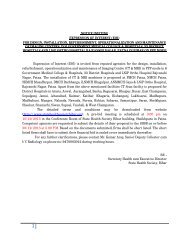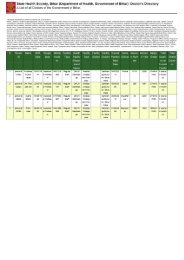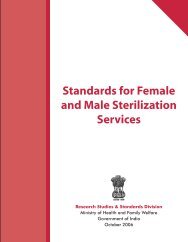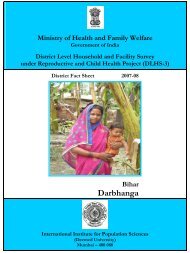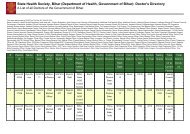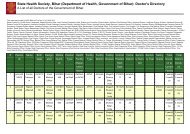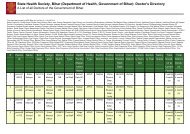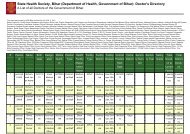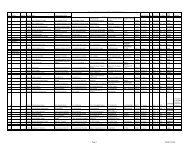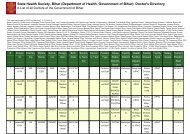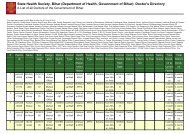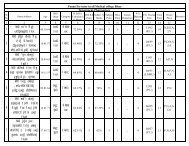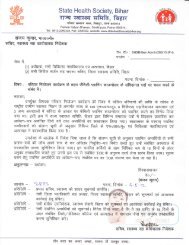District Health Action Plan - STATE HEALTH SOCIETY-----BIHAR
District Health Action Plan - STATE HEALTH SOCIETY-----BIHAR
District Health Action Plan - STATE HEALTH SOCIETY-----BIHAR
Create successful ePaper yourself
Turn your PDF publications into a flip-book with our unique Google optimized e-Paper software.
National <strong>Health</strong> Programmes<br />
1- Revised National T.B Control Programme<br />
Tuberculosis (TB) is a communicable disease caused by Mycobacterium Tuberculosis, which<br />
spreads from a diseased person to a healthy one. Germs of TB spread through air when<br />
untreated patients cough or sneeze. TB mainly affects the lungs; but it can also affect other<br />
parts of the body (Brain, Bones, Glands, etc.).<br />
Tuberculosis (TB) remains a major public health problem in India. Every year approximately<br />
18 lakh people develop TB and about 4 lakh die from it. India accounts for one fifth of global<br />
incidence of TB and tops the list of 22 high TB burden countries. Unless sustained and<br />
appropriate action is taken, approximately 20 lakh people in India are estimated to die of TB<br />
in next five years. TB kills more adults in India than any other infectious disease.<br />
In India, EVERY DAY:<br />
More than 40,000 people become newly infected with the tubercle bacilli<br />
More than 5000 develop TB disease<br />
More than 1000 people die of TB (i.e. 1 death every 1½ minutes)<br />
The best way to diagnose lung TB is by examining the sputum under a Binocular Microscope.<br />
Germs of TB can be seen with a Binocular Microscope.<br />
Despite the existence of a National Tuberculosis Control Programme since 1962, the desired<br />
results had not been achieved. On the recommendations of an expert committee, a revised<br />
strategy to control TB was pilot tested in 1993 in a population of 2.35 million, which was<br />
then increased in phased manner<br />
The Revised National Tuberculosis Control Programme (RNTCP) aims to stop the spread of<br />
TB by curing patients. The key of this strategy is to cure TB through Directly Observed<br />
Treatment at a time and place convenient to the patient.<br />
A full-fledged programme was started in 1997 and rapidly expanded in a phase manner with<br />
excellent results.<br />
By March 2004, Saran district has been covered under RNTCP. The RNTCP is an application<br />
in India of the WHO-recommended Directly Observed Treatment, Short Course (DOTS) the<br />
most effective strategy to control TB.<br />
Role of the <strong>District</strong> TB Control Society/<strong>District</strong> TB Centre<br />
The TB programme will provide orientation, training, technical assistance, quality assurance<br />
of laboratory services, and supervision and monitoring of activities. It will also refer<br />
tuberculosis patients with serious complications who require hospitalization.<br />
First time Saran district is under Target zone after RNTCP launched. The cure rate is<br />
increased upto 85 %. That is due to good performance of all the TUs. They maintain the track<br />
records of High Detection and High cure rate upto 85 %.<br />
52 | P a g e D i s t r i c t H e a l t h A c t i o n P l a n 2 0 1 2 - 1 3 D H S , S a r a n



